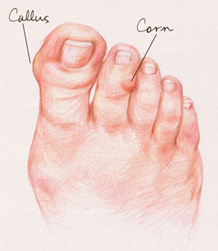
What are corns and callous?
Corns and callus are areas of thickened skin that occurs in the area of pressure. They are actually a normal and natural way for the body to protect itself.
Corns are hyperkeratosis of the skin, this thickening of the surface layer of the skin is in response to continues pressure on the skin.
Corns usually form on the toes, where the bone is prominent and presses the skin against the shoe, ground or the bone. As corn becomes thick the tissue under the corn are subject to increased irritation. Corn is thickest and most painful. If corns become inflamed, there is pain and sometimes swelling and redness.
Calluses are thickened pads of skin, usually on weight-bearing portion of the sole. They also can develop on the hand if excessive pressure and friction occurs for example: gymnastics, weightlifting etc.
Generally it affects pressure sites. Mainly over head of first and fifth metatarsal bone, heel.
What is the classification of corns and callus?
Corns:
1. Hard corn (heloma durum): it is the small patch of thickness, dead skin with a packed nucleus. They are found on a dry flat skin surface.
2. Soft corn (heloma mole): this type of corn has a thinner surface and they usually stay moist even though their center is hard. Most often they are found between the toes.
Callus:
• Common callus: This usually occurs due to friction on hands and feet.
• Plantar callus: these are a common type of callus found on the sole of the foot.
• Hereditary callus: These type of callus runs in the family and are usually found on the sole or palms.
Corns and callus Occur due to?
– Continuous pressure and friction over the prolonged period.
– Ill-fitted shoes
– Extended high heels
– Over manual labor like weightlifting/gymnastics.
Do corns come back?
There is no guarantee that the corn or callus won’t come back. Corns and calluses are easier to prevent than to treat. At times, a surgery or a local procedure can be recommended to excise a plantar corn/ callus.
What are the signs and symptoms of corns and callus?
• The skin may be dry, waxy transparent or a horny mass.
• Usually, pain in feet or heel on standing or walking
• Variations in temperature, especially cold, dampness which causes spontaneous pain.
Do corns go away on their own?
In most cases corns are not a serious health problem, although they can be very painful. If you are physically fit and remove the cause of the corn or callus, it will usually go away on its own. If you have corns or calluses it should disappear within a month if you remove your maintaining cause like replacing your footwear and stopping the activity causing the corns.
What happens if a corn is left untreated?
A corn is actually a type of callus. Corns usually found on the bottom of the foot, occur when sweat ducts are blocked. Corns and calluses can cause foot pain while walking & discomfort, and left untreated, they can result in serious side effects. Patient will not able to do his routine work as walking will be painful.
Is a corn painful?
Corns are smaller than callus in appearance and have a hard center surrounded by inflamed skin. Corns tend to appear on parts of your feet that don’t bear weight, such as the tops and sides of your toes and even between your toes. They can also be found in weight-bearing areas. Corns can be painful when you press it.
Do corns have black dots?
Corns can also be painful too. Plantar warts are hard and flat, with a rough surface and circular shape. Plantar warts often have a center that appears as one or more pinpoints black dots whereas a corn would never have these black “dots”. Generally people get confuse between corn and warts.
What are the homeopathic indications for corns and callus?
• Antimonium crudum
• Ferrum Picricum
• Graphites
• Lycopodium
• Natrium muriaticum
• Silicea
• Sulphur
